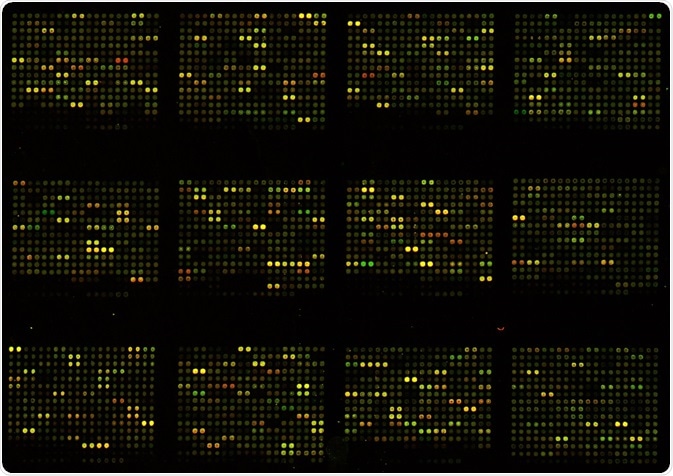Small molecule microarrays allow screening of biomolecules such as peptides and carbohydrates. By immobilizing these small molecules on a microarray, interactions can be quickly assessed through a high throughput process.

Credit: Andre Nantel/Shutterstock.com
Characterization of small molecule interactions is not as defined as other reaction types, such as DNA hybridization. The production of small molecule microarrays allows insight into enzyme-substrate complexes and discovery of new ligands. The large-scale assessment of these interactions can be utilized for identification of novel drugs by providing an important first step in the drug discovery pathway and enabling the formation of more potent and selective therapeutics.
How small molecule microarrays work
Microarrays produce highly parallel experiments for identifying small molecules which directly interact with a target biomolecule. The laboratory tool is fabricated as a microscopic slide with thousands of spots in a simple row formation. High precision robotic printers are then used to automatically deposit around 5000 molecules on a standard microscopic glass slide with a spot diameter between 80 and 200 micrometers.
The molecules are then immobilized on the microarray using capture agents such as antibodies and chemical tags. The wells are probed with a biomolecule of interest that is tagged with a fluorophore and a binding event is detected through a fluorescence-based readout. An alternative technique involves employing antibodies labeled with fluorophores to detect the small molecule interactions on the microarray.
New developments in small molecule microarray design include a nonselective approach to immobilization via photoactivation on gold-coated chips and the non-covalent capture of small molecules through fluorous affinity interaction. The latter method is particularly useful for experiments involving small molecules that are biased towards proteins with a specific displayed orientation.
Applications in drug discovery
The first step in the development of new therapeutic agents is the evaluation of small molecules and their interactions. Small molecule microarrays are employed in screening drug targets to understand molecular interactions. The advantage of microarray technology is that multiple reactions can be performed at a time with the ability to easily visualize positive interactions.
Protein interactions are an important source of potential targets for drug development and numerous proteins have recently been linked to disease. Application of these proteins to drug discovery is difficult because many of the associated proteins have an undefined structure and function.
Small molecule microarrays can be utilized in such cases because they do not require knowledge of the structure and functions of the protein in advance. Small molecule microarrays are typically prepared with covalently immobilized small molecules that are then probed with a protein target.
Ligand discovery examples
Important protein-ligand interactions have been discovered using small molecule microassays, including from protein classes such as transcription factors and proteases. Histone deacetylases are a type of enzyme and an important therapeutic target. This is because they have a fundamental role in transcriptional regulation and are associated with a variety of diseases.
Small molecule microarrays have been utilized as a tool for determining the importance of small molecules that bind to histone deacetylases and their potential in therapeutic design. Several small molecule probes of histone deacetylases function have been developed, providing greater understanding of the interactions between histone deacetylases and naturally occurring inhibitors. Such experiments have led to the formation of guidelines for designing synthetic histone deacetylases inhibitors.
By further understanding small molecule structure and interactions, more potent therapeutic treatments can be designed including the formation of increasingly selective histone deacetylases inhibitors.
Sources:
- Duffner, J.L. et al. 2007. A pipeline for ligand discovery using small-molecule microarrays, Current Opinion in Chemical Biology, 11, pp. 74-82.
- Uttamchandani, M. & Yao, S.Q. 2017. The expanding world of small molecule microarrays, Methods in Molecular Biology, 1518, pp. 1-17.
- Hong, J.A. et al. 2014. Recent discoveries and applications involving small-molecule microarrays, Current Opinion in Chemical Biology, 18, pp. 21-28.
- Vegas, A.J. et al. 2008. Small-molecule microarrays as tools in ligand discovery, Chemical Society Reviews, 37, pp. 1385-1394.
- Bolden, J.E. et al. 2006. Anticancer activities of histone deacetylase inhibitors, Nature Reviews Drug Discovery, 5, pp. 769-784.
Further Reading
Last Updated: Feb 26, 2019